#north west Ireland
Explore tagged Tumblr posts
Text



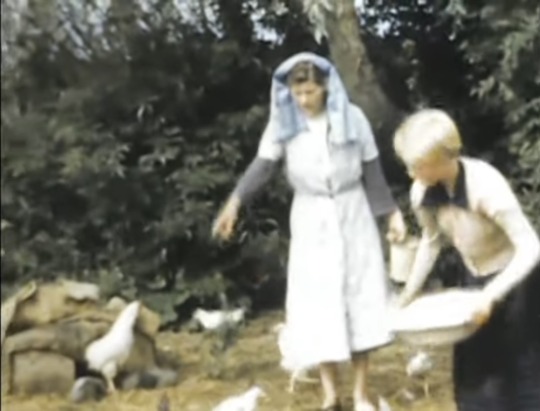
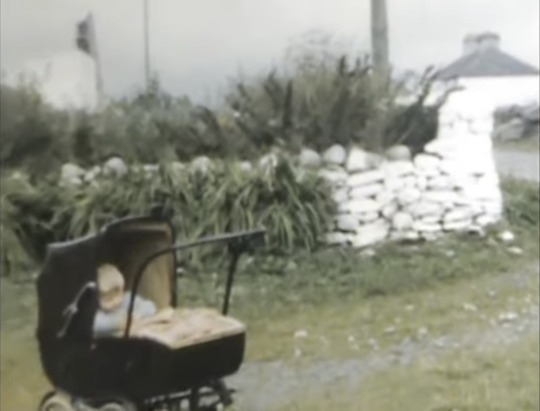

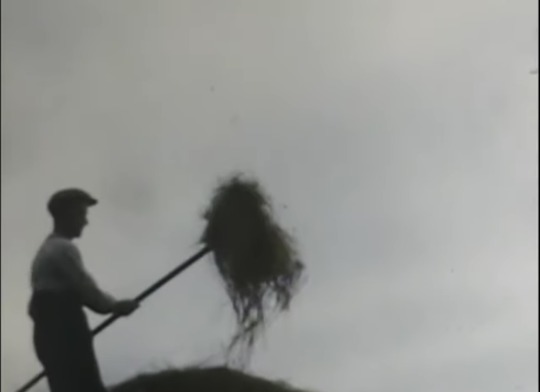
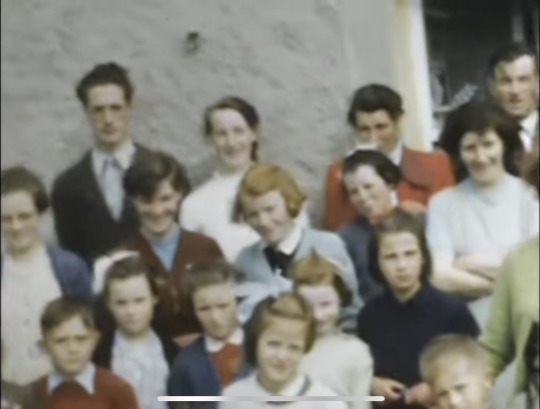
Sligo, Ireland 1956
#sligo#ireland#north west ireland#west ireland#vintage#photography#nature#old ireland#Easkey#Irish#own post#50s#1950s
58 notes
·
View notes
Text

Kneecap (dir. Rich Peppiatt).
[The] controversial West Belfast hip-hop trio, [...] known for rapping republican lyrics in their native Irish language, star in their own titular biographical film about their rise to fame and infamy. Set in 2019, [...] Peppiatt directs the plainly titled Kneecap with an energetic, riotous verve to its provocative, explicitly anti-UK material of rebellion.
#kneecap#kneecap movie#michael fassbender#movie review#movies#movie#film review#film#sony pictures classics#belfast#west belfast#indie film#indie movie#cinema#irish film#rich peppiatt#northern ireland#north of ireland#irish language#jessica reynolds#mo chara#móglaí bap#moglai bap#dj próvaí#dj provai#liam og o hannaidh#naoise o caireallain#jj o dochartaigh#rap#bfi
31 notes
·
View notes
Text
Man Dublin North West has the worst fucking candidates
#funny#memes#politics#comedy#ireland#irish politics#political memes#irish#irish meme#erection 2024#election#dublin north west
10 notes
·
View notes
Text

“My name is Jemma Dolan. I am a MLA in Ireland. I’m appalled by the silence regarding war crimes committed by the Israeli government. I, & many with me, demand a ceasefire, open humanitarian corridors. Facilitate for water, food and medicine to Gaza now!”
#jemma dolan#sinn fein#ireland#north ireland#rafah#free palestine#palestine#politics#world news#israel#news#human rights#jerusalem#west bank#gaza
25 notes
·
View notes
Text
no appreciation for corncrakes on this webbed site. look how pretty he is!!!
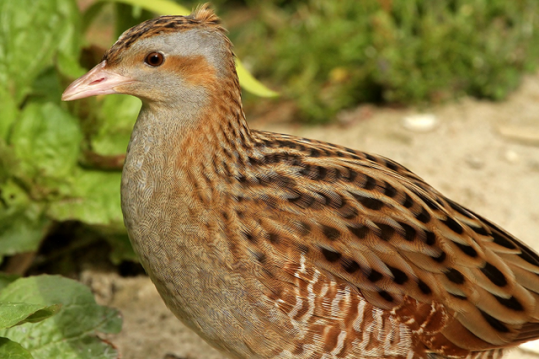
#contact call#also they have a funny call. it's where their scientific name (crex crex) comes from#they are in the rail family! so related to coots and moorhens#and they breed in europe but go all the way down to south africa to winter. despite looking like a chicken#and they have declined so much in ireland :(#restricted to small areas mostly on the west and north coasts of the mainland and some islands
4 notes
·
View notes
Text
instagram
Via Instagram: @ykhong
Read through all the slides. More than one country has been divided by the Empire for their own greed.
#free palestine#palestine#from the river to the sea palestine will be free#free gaza#gaza#west bank#free west bank#india#pakistan#bangladesh#south korea#north korea#korea#partition#british empire#british imperialism#ireland#this is a genocide#genocide#education is important#end the genocide#end the occupation#Instagram
6 notes
·
View notes
Text
Okay, I was inspired by the previous blog I reblogged and found a geoguessr for Ireland!!
I'm curious to see how people do!
#I'm a lot better at the south/west- I learned that I need to touch up on the north a bit more lol#not art#quiz#ireland
6 notes
·
View notes
Text
US diplomat: "Okay, so you bought some of Alaska's land from Russia, okay, okay. But...your people live on the other side of the world, and, let's be real here, we're too racist to respect you as equals. Why should we honour your deal with the Russian Empire when we can just...waltz in and annex your little home away from home?"
Tsalal Alaskan colonist leader: "Good question! Do you see this missile, this one right here, bigger than a train? Its warhead is filled with several tons of fuel-air explosives. Now, I'm not saying that we have a dozen of these things stocked on ships ready to fire at any given moment and a bunch of fanatical suicide pilots ready to fly them ludicrous distances into your nearest population centers...
"But I'm not not saying that."
#and so the alaskan enclave hangs around until maybe. 1930 ish.#writing#the entire north sphere has collapsed by 1940 due to extreme logistics issues hostile neighbours and a closing of the tech gap#at its height it encompasses a piece of alaska (peaceful)#western Ireland (hahaha not peaceful)#iceland greenland a scrap of siberia parts of west africa and some islands#but it only spans all those areas for a couple of years and in the end most of them get ethnically cleansed#still its fun to give the western world a taste of that conquistador medicine for a little while#along with some lingering cultural trauma#alaska is the beginning of the end and also results in the russian tsars coming off life support and the birth of an alt-soviet style state#they don't get scotland in this au and they certainly don't have northern holdings by the 21st century
2 notes
·
View notes
Text
i provided so much delight to my grandad when i found out he had ancestors that had been living in villages near the one he moved to for retirement for centuries and that it wasn't just post potato famine extreme poverty for his family and my mum loved it when i told her that her ancestors has spent so much time in the village that she could see out of her childhood bedroom window and that a hundreds of years old font that got moved to the church where her school had services was where where her 5x great grandfather and his siblings were baptised
#genealogy has really improved my relationship with my family#you should research your family history!#and if you are from the following pretty please tell me about it we might be related#west country: bristol mendips taunton#greater manchester#west yorkshire especially huddersfield#mid suffolk#derby nottingham area#humber shipping industry#potato famine stricken parts of ireland#east of swindon#and just north of the cotswalds#ephemeriee.txt
1 note
·
View note
Text



A holistic and natural treatment such as acupuncture can treat a wide range of injuries and conditions such as the following: sports injuries, back pain, knee pain; shoulder issues, immune response, tennis elbow, fibromyalgia & sciatica.
#North Dublin#South Dublin#West Dublin#North Kildare#ireland#acupuncture treatment#acupuncture clinic#acupressure#acupuncturist#acupuncture#county kildare#dublin#universal acupuncture#sports injuries#back pain#knee pain; shoulder issues#immune response#tennis elbow#fibromyalgia
0 notes
Text




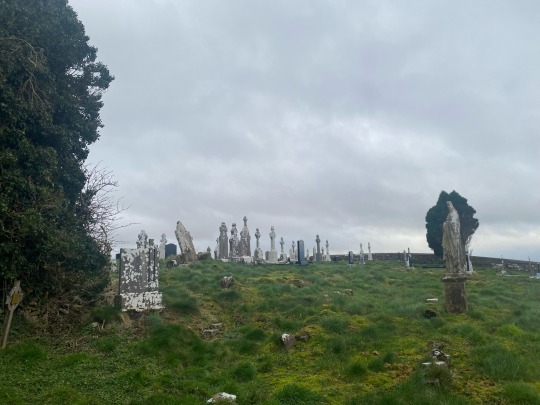

Graves of rural Ireland
#ireland#irish#this is where my great grandmother and alot of my maternal family is buried#Catholic#graveyard#cemetery#rural ireland#history#photography#north west Ireland#west ireland#they look higher quality if u click on to the pics for some reason#own post
158 notes
·
View notes
Text
Yeah the people in the notes going "obviously the government isn't the people" are missing the point, which is that being white and western and therefore a beneficiary of the colonial order consistently breeds racism and apathy towards the suffering of Black and brown and Global South people. Ireland maybe a little better than the rest of Europe but at the end of the day there's still no incentive to interrogate their privilege. Praising it inordinately for showing the bare minimum of decency allows them to cover up all the ways they're also complicit and uninvested. Give the privileged an inch and they take a mile.
anyway in the past week the irish government has voted down two motions which would have condemned the genocide in gaza.
i need everyone to stop lionising ireland as if its not also a european government with strong ties to the us. american weapons pass through shannon airport and will continue to, because yesterday the motion to stop that was voted down 83 to 50.
other governments have done much more but somehow people still act as though ireland is the ultimate palestinian ally and exempt from criticism on its handling of palestine bc it was once colonised, even though that past experience clearly isnt being taken into account by the irish government when creating policy.
i live here i know there’s a lot of public support and sympathy for palestine, which is great, but that isnt reflected in government, and i think ireland should be treated like other countries whose governments have done nothing.
#prev tags ->#living in dublin is so surreal like ive had conversations with ppl where theyre like i support palestine#but when i invite them to protests they dont come. when racism happens IN FRONT OF THEM they say oh thats a minority#oh thats not all irish people. like OKAY but one irish people just physically assaulted ur friend and ur worried abt irish ppls reputation?#if this makes you uncomfortable to hear like. good. im so over it ❤️#my tags: yeah this is par for the course with white people#also suffering yourself doesn't necessarily make you empathetic to the same suffering when other people go through the same#especially people you're privileged over#it's why most of the colonized world immediately turned around and genocided and colonized whoever around them was weaker#dont forget the right wing movement in ireland rioting against immigration#i single out whiteness because the colour system of race was created to rationalise and justify oppression#and both settler and extractive colonialism#in short to create the Global South#all white and western people benefit from the global south and all white people benefit from the oppression of BIPOC#it's very function to create this kind of systemic and cultural sociopathy#i think that relatively more people in ireland are sympathetic to palestine than most other white countries#but that doesn't mean much when you take whites and the west as a whole#it means even less in terms of their government#pretty sure ireland abstained from one of the UN ceasefire votes in Oct. i forget#but in general people on this site tend to search for champions and heroes and whatever to prop up this idealization/demonization binary#instead of understanding things on a systemic level#which is further evidence of why I call this site white liberal hell lmao#nothing is more derailing and destructive to a cause than valorising its advocates#western imperialism#white supremacy#global north#european politics#ireland#free palestine
5K notes
·
View notes
Text
Environment: Death Cap Mushrooms are Extremely Deadly—and They’re Spreading
The Invasive Death Cap Mushroom is thriving in North America. While it can be difficult to distinguish from an edible one, make no mistake: It can do a number on you.
— By Emily Martin | August 31, 2023

The Death Cap is the World's Deadliest Fungus, responsible for 90 percent of the World's Mushroom-related Poisonings every year. Native to Europe, Death Caps have spread around the World over the past Century. Photograph By Yves Lanceau/Nature Picture Library
The name itself is both alarming and self-explanatory: the death cap mushroom.
Scientifically known as Amanita phalloides, death caps are responsible for 90 percent of the mushroom-related fatalities that occur every year, making them the world’s most lethal mushroom. The infamous fungus was recently in the news after three people in Australia died after ingesting what investigators suspect were death caps.
The mushroom originates from the U.K. and parts of Ireland, but over the past century, it has hijacked trips around the world, spreading to Australia and North America.
Since arriving on the West Coast, the invasive mushroom has spread rapidly throughout California and has even appeared as far north as British Columbia, but much about its arrival remains a mystery. Why the mushroom spread so quickly, when exactly it arrived, and how it will impact the environment it grows in are the topics of ongoing research.
Here’s what you need to know about this deadly mushroom—and how to spot one—in case it emerges in a forest near you.
How The Mushroom Earned Its Name
The unassuming mushroom can grow up to six inches tall with a similarly sized domed cap, sometimes tinged yellow or green. Under its cap are white gills and an off-white stem—characteristics that make it difficult to distinguish from an edible mushroom.
Yet unlike an edible mushroom, it can cause extreme damage to the liver and kidneys, or in some cases, death.
That’s because the mushrooms contain a unique set of toxins, says U.S. Department of Agriculture plant pathologist Milton Drott. Though it is safe to the touch, a death cap contains amatoxins, which prevent cells from creating proteins, ultimately causing cell death and organ failure.
Drott notes that these toxins may have allowed the populations spreading through the U.S. to thrive, serving up a defense against any new predators the fungus encounters in its environment.
But studying the death cap mushroom can be difficult. It’s challenging to replicate ideal environmental conditions for a mushroom in a lab, and studying plucked mushrooms requires complex DNA sequencing.
Some fungi can damage the environment, like the fungus that wiped out American Chestnut trees, but so far, there’s no strong evidence that death caps are a threat to their new environments. In fact, trees and other plants benefit from their presence.
Death caps are a mycorrhizal fungi, which means they form a relationship with plants that’s mutually beneficial for both plant and fungus. The plant receives nutrients from the soil that the fungus extracts, while the fungus receives sugars from the plant.
A Mysterious Move Around The World
It’s nearly impossible to pinpoint the actual moment the deadly mushroom made its way to the western U.S. and why exactly it’s continued to spread since then, says Anne Pringle, a mycologist at the University of Wisconsin-Madison and a leading expert on death caps.
The earliest record of the mushroom in California is from the 1930s. Some researchers theorize that death caps immigrated in the soil of a cork tree transported from Europe to California to make corks for a then burgeoning wine industry. Others say the mushroom may have hitched a ride on a mystery plant imported to beautify college campuses.
Regardless, both Pringle and Drott say the only thing they’re certain of is that the fungus was likely dormant—and thus hidden from human eyes—in an imported plant’s soil.
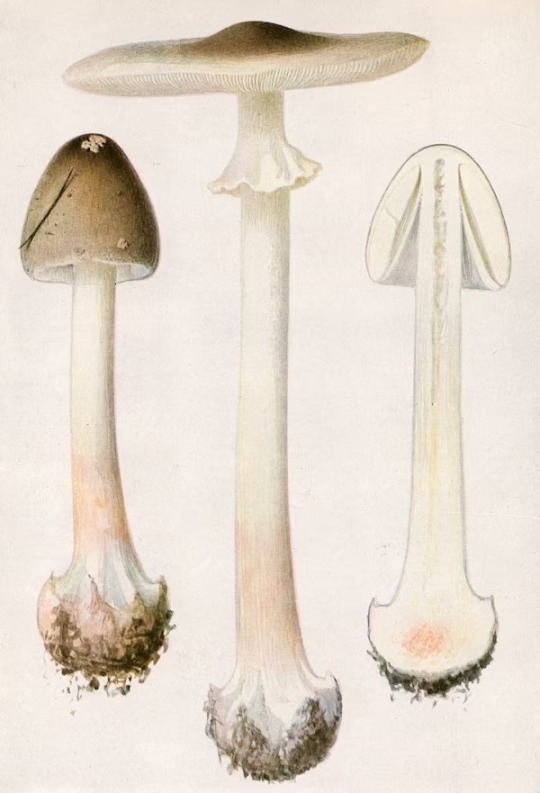
Scientifically known as Amanita Phalliodes—Death Caps were first spotted in California in the 1930s. Some scientists think they were imported in the soil of cork trees, used to make corks for California's wine makers.
“When they planted that tree in the ground, they also effectively planted the fungus. So, what exactly is the smoking gun, who did it, and when—that's the thing I think we'll never truly know,” Pringle says.
Pringle can’t say for sure what makes the state such a friendly habitat for the invasive species, but she does note that the fungus can tolerate different environments throughout Europe, growing as far north as Sweden and as far south as southern France.
Since arriving, Pringle says its geographic extent has grown larger and spread to other States; most recently it appeared in Idaho.
Retracing Their Steps
When scientists first spotted death caps in the U.S., they thought they may be native to the region because of how widespread they are.
In 2009, Pringle was the first to label the population in California as invasive, a discovery she made by inspecting the mushrooms’ DNA.
“When they planted that tree in the ground, they also effectively planted the fungus. So what exactly is the smoking gun, who did it and when, that's the thing I think we'll never truly know.”
— Anne Pringle
And when scientists did realize the death cap had newly spread into the U.S., there wasn’t any preexisting data to provide clues about where exactly it entered North America and how quickly it multiplied.
“There's so many ideas to test, it’s hard to even know where to get started,” Pringle says.
Research on invasive fungi in the environment is quite new, Pringle says, so answers to questions of why death caps are spreading and its impact on local ecosystems may still be years away.
Drott thinks the mushroom may be proliferating because it thrives in its new soil and with its adoptive plants, or there may be a lack of predators in these new habitats to keep death cap populations in check.
His research has revealed at least one clue: the genes responsible for producing toxins in American death caps are extremely unique, distinct from their genetic cousins in Europe, and may be the key to understanding how the invasive plant has thrived in North America.
Earlier this year, scientists published preliminary research suggesting the death cap can reproduce both with and without a mate, and that a single fungus can live a long, reproductive life.
Encountering A Death Cap
Spotting a death cap requires vigilance.
“It’s scary that these [pass for] delicious mushrooms,” Drott says.
He adds that, in addition to an unalarming physical appearance, the death caps’ toxins don’t smell or provide any other obvious giveaways. Its toxins are also extremely stable when heated and don’t break down when cooked, unlike other edible fungi that are only dangerous to eat raw.
That’s why scientists suggest erring on the side of caution and steering clear of foraging mushrooms. Pringle also emphasizes the importance of learning the plants in your local environment.
“If you can tell the difference between Swiss chard and spinach, you can learn difference between edible and poisonous mushrooms,” Pringle says, emphasizing the small but recognizable differences between the two greens. “People want a magic rule, but there’s nothing I can hand you in a sentence or paragraph."
Rather, she says identifying physical differences between death caps and a safe mushroom can become easier with exposure.
Spreading Awareness
Many death caps have been found in National Parks, including Point Reyes National Seashore in California, where Pringle assisted with a study on the invasion in 2010.
National Park Service (NPS) science advisor Ben Becker notes that parks are constantly seeing new invasive species with the frequent movement of people and equipment, and the death cap is a good example of how humans can transport tiny fungal invaders around the world.
Becker says NPS works with local mushroom science groups like the Bay Area Mycological Society to spread public awareness about the dangers of foraging mushrooms.
If you’re concerned about something you have eaten, go to the emergency room and if possible, take pieces of the mushroom you ate for identification.
And as many foragers and scientists say, don’t munch on a hunch.
#Environment#Mashroom | Amanita Phalliodes—Death Caps#Spotted | California | 1930s#Imported | Soil | Cork Trees 🌲#Extremely Deadly#Invasive#North America 🇺🇸#Difficult | Distinguish#Emily Martin | National Geographic#Native | Europe 🇪🇺#Deaths | Australia 🇦🇺#UK 🇬🇧 | Ireland 🇮🇪#West Coast | California | US 🇺🇸#British Columbia#U.S. Department of Agriculture | Plant 🌱 Pathologist | Milton Drott#Toxins#Thrive#Complex DNA Sequencing#Fungus | Wiped Out | American Chestnut 🌰 Trees 🌲#Anne Pringle | Mycologist | University of Wisconsin-Madison#Sweden 🇸🇪 | France 🇫🇷#Idaho#Vigilance#Swiss Chard | Spinach#Dangerous | Eat Raw#National Parks | Point Reyes National Seashore in California#National Park Service (NPS)#Science Advisor | Ben Becker#Bay Area Mycological Society
0 notes
Text
THE NEW BUS PLAZA THAT I DID NOT KNOW ABOUT
The opening of the new bus plaza will support a 75% increase in bus services. The revised network will see the number of buses increase from 12 buses per hour per direction to 21.
AT LIFFEY VALLEY SHOPPING CENTRE I started out with the intention of visiting Chapelizod today and got the the G2 bus instead of the 26. I knew that the 26 served Chapelizod on it way to Liffey Valley but I missed the 26 by about two minutes and the G2 which goes to Liffey Valley arrived a few minutes later so I boarded it. Much to my surprise it took a very long time to get to Liffey Valley and…

View On WordPress
#€20m bus plaza facility#26 Bus#BusConnects programme#dublin bus#Fotonique#FX30#G2#Infomatique#Ireland#Liffey Valley#Liffey Valley Shopping Centre#North Kildare#Public Transport#Sony#south dublin#West Dublin#William Murphy
0 notes
Photo

200 million ya, Ireland and Scotland were a part of the same range as the Appalachian mountains, where, funny enough, the majority of Scottish and Irish emigrants settled in America.
from Evolution of the Rheic Ocean via u/MUNKIESS
The Rheic Ocean, which separated Laurussia from Gondwana following the closure of Iapetus, is arguably the most important ocean of the Palaeozoic. Its suture extends from Mexico to Turkey and its closure produced the climactic Variscan–Alleghanian–Ouachita orogeny that assembled the supercontinent, Pangaea.Following protracted Cambrian rifting that represented a continuum from Neoproterozoic orogenic processes, the Rheic Ocean opened in the Early Ordovician with the separation of several Neoproterozoic arc terranes from the continental margin of northern Gondwana.
Separation occurred along the line of a former Neoproterozoic suture following the onset of subduction in the outboard Iapetus Ocean. The timing of rift–drift transition and drive for subsequent spreading was likely governed by slab pull, accounting for the rapid rate (8–10 cm/yr) at which the Rheic Ocean widened.During the Ordovician, the ocean broadened at the expense of Iapetus and attained its greatest width (~ 4000 km) in the Silurian, by which time Baltica had sutured to Laurentia and the Neoproterozoic arc terranes had accreted to Laurussia, closing Iapetus in the process.
Closure of the Rheic Ocean began in the Devonian and was facilitated by northward subduction beneath southern Baltica and southward subduction beneath northwest Gondwana. Closure was largely complete by the Mississippian as Gondwana and Laurussia sutured to build Pangaea, North Africa colliding with southern Europe to create the Variscan orogen in the Devonian–Carboniferous, and West Africa and South America suturing to North America to form the Alleghanian and Ouachita orogens, respectively, during the Carboniferous–Permian.The Rheic Ocean consequently plays a dominant role in the basement geology of southern Europe, in the Appalachian–Ouachita orogeny of North America, and in the Palaeozoic sedimentary, structural and tectonothermal record from Middle America to the Middle East. With its closure, the ocean brought about the assembly of Pangaea and brought the Palaeozoic Era to an end.
2K notes
·
View notes
Text
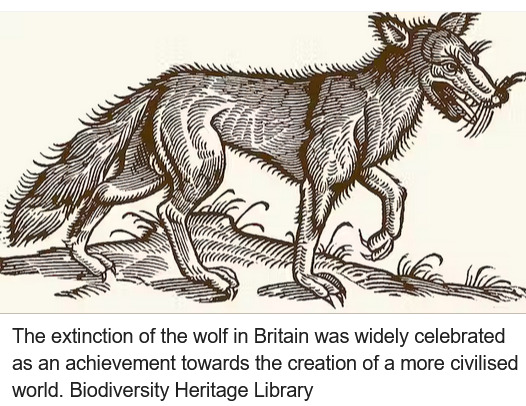


Travel back [...] a few hundred years to before the industrial revolution, and the wildlife of Britain and Ireland looks very different indeed.
Take orcas: while there are now less than ten left in Britain’s only permanent (and non-breeding) resident population, around 250 years ago the English [...] naturalist John Wallis gave this extraordinary account of a mass stranding of orcas on the north Northumberland coast [...]. If this record is reliable, then more orcas were stranded on this beach south of the Farne Islands on one day in 1734 than are probably ever present in British and Irish waters today. [...]
Other careful naturalists from this period observed orcas around the coasts of Cornwall, Norfolk and Suffolk. I have spent the last five years tracking down more than 10,000 records of wildlife recorded between 1529 and 1772 by naturalists, travellers, historians and antiquarians throughout Britain and Ireland, in order to reevaluate the prevalence and habits of more than 150 species [...].
In the early modern period, wolves, beavers and probably some lynxes still survived in regions of Scotland and Ireland. By this point, wolves in particular seem to have become re-imagined as monsters [...].
Elsewhere in Scotland, the now globally extinct great auk could still be found on islands in the Outer Hebrides. Looking a bit like a penguin but most closely related to the razorbill, the great auk’s vulnerability is highlighted by writer Martin Martin while mapping St Kilda in 1697 [...].
[A]nd pine martens and “Scottish” wildcats were also found in England and Wales. Fishers caught burbot and sturgeon in both rivers and at sea, [...] as well as now-scarce fishes such as the angelshark, halibut and common skate. Threatened molluscs like the freshwater pearl mussel and oyster were also far more widespread. [...]
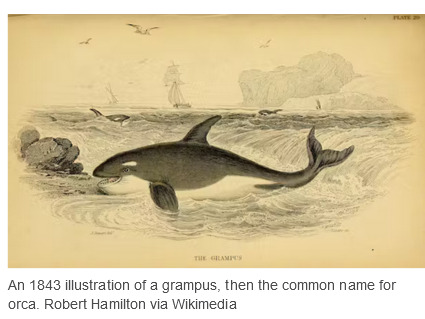
Predators such as wolves that interfered with human happiness were ruthlessly hunted. Authors such as Robert Sibbald, in his natural history of Scotland (1684), are aware and indeed pleased that several species of wolf have gone extinct:
There must be a divine kindness directed towards our homeland, because most of our animals have a use for human life. We also lack those wild and savage ones of other regions. Wolves were common once upon a time, and even bears are spoken of among the Scottish, but time extinguished the genera and they are extirpated from the island.
The wolf was of no use for food and medicine and did no service for humans, so its extinction could be celebrated as an achievement towards the creation of a more civilised world. Around 30 natural history sources written between the 16th and 18th centuries remark on the absence of the wolf from England, Wales and much of Scotland. [...]
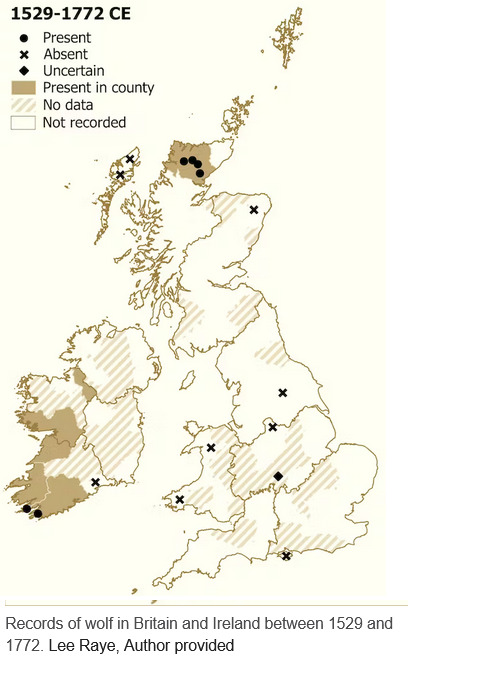
In Pococke’s 1760 Tour of Scotland, he describes being told about a wild species of cat – which seems, incredibly, to be a lynx – still living in the old county of Kirkcudbrightshire in the south-west of Scotland. Much of Pococke’s description of this cat is tied up with its persecution, apparently including an extra cost that the fox-hunter charges for killing lynxes:
They have also a wild cat three times as big as the common cat. [...] It is said they will attack a man who would attempt to take their young one [...]. The country pays about £20 a year to a person who is obliged to come and destroy the foxes when they send to him. [...]
The capercaillie is another example of a species whose decline was correctly recognised by early modern writers. Today, this large turkey-like bird [...] is found only rarely in the north of Scotland, but 250–500 years ago it was recorded in the west of Ireland as well as a swathe of Scotland north of the central belt. [...] Charles Smith, the prolific Dublin-based author who had theorised about the decline of herring on the coast of County Down, also recorded the capercaillie in County Cork in the south of Ireland, but noted: This bird is not found in England and now rarely in Ireland, since our woods have been destroyed. [...] Despite being protected by law in Scotland from 1621 and in Ireland 90 years later, the capercaillie went extinct in both countries in the 18th century [...].
---
Images, captions, and all text above by: Lee Raye. “Wildlife wonders of Britain and Ireland before the industrial revolution – my research reveals all the biodiversity we’ve lost.” The Conversation. 17 July 2023. [Map by Lee Raye. Bold emphasis and some paragraph breaks/contractions added by me. Presented here for commentary, teaching, criticism purposes.]
1K notes
·
View notes